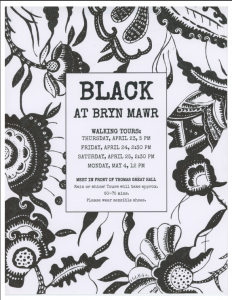Category Archives: Conferences & Events
Wiki Education Foundation at Bryn Mawr
 This month, the Greenfield Digital Center for the History of Women’s Education and Bryn Mawr LITS are pleased to partner with the Wiki Education Foundation to discuss how and why instructors might consider building Wikipedia assignments into coursework.
This month, the Greenfield Digital Center for the History of Women’s Education and Bryn Mawr LITS are pleased to partner with the Wiki Education Foundation to discuss how and why instructors might consider building Wikipedia assignments into coursework.
On Tuesday, February 16 from 4:30-6pm in the Quita Woodward Room (Thomas Hall), we will host a workshop with Jami Mathewson, Educational Partnerships Manager at Wiki Ed, who will introduce the resources and tools available to support instructors teaching with Wikipedia. Jami will bring ideas from the NWSA women’s studies initiative, and share new plans for 2016’s Wikipedia Year of Science — including ways for instructors and students to join efforts aimed at increasing the representation of women in science on Wikipedia.
RSVP for the workshop here. Bring your devices, your questions, and your ideas!
Wikipedia and Women’s Studies
For more than a year, we’ve been following the National Women’s Studies Association’s Wikipedia Initiative, addressing the vast gender gap on Wikipedia. The easiest way to improve Wikipedia’s representation of women, they have shown, is to participate in the Wikipedia Education Program, a project in which students contribute content to Wikipedia in place of a traditional research paper through a classroom activity. The Wikipedia Education Program in the United States and Canada is run by the Wiki Education Foundation, a nonprofit organization that builds connections between universities and Wikipedia and other Wikimedia projects in the United States and Canada.
About Wikipedia
One of the world’s most widely read websites, with approximately 550 million unique visitors per month, Wikipedia articles are often the number one hit when using a search browser. Its broad public presence, open for editing to anyone, offers a unique opportunity to participate in an online community of practice.
Why teach with Wikipedia?
As an educational tool, the development of Wikipedia articles allows students to create collaborative work with a visible impact on a global audience. Whether adding new sources to existing Wikipedia pages or creating new pages on notable topics, students gain deeper insight into their course material and learn to evaluate critically the reliability of sources. With faculty and students reporting enthusiasm and high levels of motivation for the Wikipedia assignment over the more traditional, Wikipedia assignments have the potential to deliver education that goes beyond a semester.
Questions? Contact Monica L. Mercado, Director of the Greenfield Digital Center, at mmercado@brynmawr.edu. All are welcome.
“Teaching History through Archives” at AHA 2016
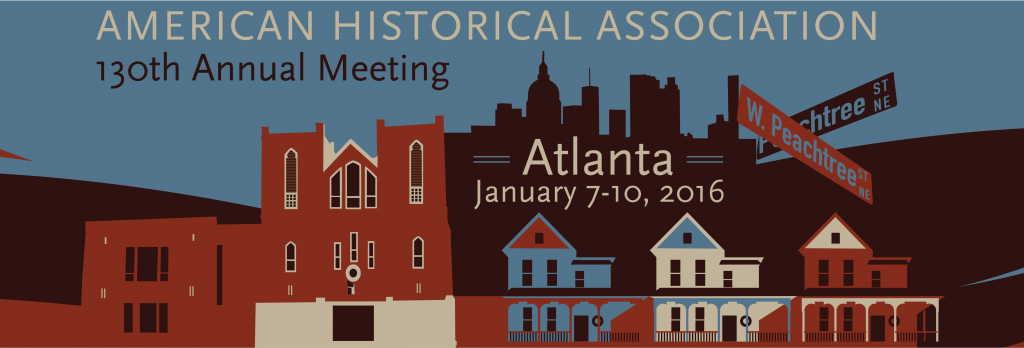 Going to AHA 2016? Greenfield Director Monica Mercado will be co-chairing the Committee on Women Historians mentoring/brainstorming session on Saturday, January 9, and later that day will be speaking about Bryn Mawr College projects on the panel “Teaching History through Archives.” Her paper, “Archives Praxis: Supporting Independent Study and Experiential Learning in Special Collections,” will detail student work including “Black at Bryn Mawr” and “We Are/We Have Always Been,” initiated by undergraduate student researchers:
Going to AHA 2016? Greenfield Director Monica Mercado will be co-chairing the Committee on Women Historians mentoring/brainstorming session on Saturday, January 9, and later that day will be speaking about Bryn Mawr College projects on the panel “Teaching History through Archives.” Her paper, “Archives Praxis: Supporting Independent Study and Experiential Learning in Special Collections,” will detail student work including “Black at Bryn Mawr” and “We Are/We Have Always Been,” initiated by undergraduate student researchers:
For more on the conference, follow the #AHA16 Twitter stream or search the online program.
‘College Women’ Goes West: DLF Forum 2015
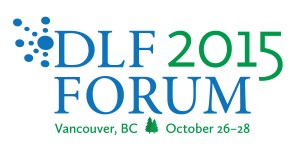 We’re in beautiful Vancouver, BC this week for the Digital Library Federation Forum. On Tuesday afternoon, Greenfield Director Monica Mercado, Bryn Mawr College digital collections librarian Rachel Appel, and Vassar College Libraries digital initiatives librarian Joanna DiPasquale will be presenting a project update on our archives portal, College Women: Documenting the History of Women in Higher Education.
We’re in beautiful Vancouver, BC this week for the Digital Library Federation Forum. On Tuesday afternoon, Greenfield Director Monica Mercado, Bryn Mawr College digital collections librarian Rachel Appel, and Vassar College Libraries digital initiatives librarian Joanna DiPasquale will be presenting a project update on our archives portal, College Women: Documenting the History of Women in Higher Education.
There’s a few ways to follow along:
- At DLF? Join our session in Ballroom I [Sched link here].
- Twitter: #DLFforum
- Crowdsourced note taking: Google Docs
- Livestream (starting at 1:30 PDT, 4:30 EST): sign up to receive login information.
We’re looking forward to presenting with the University of Virginia Scholars Lab project Take Back the Archive, a public history project created by UVa faculty, students, librarians, and archivists to “preserve, visualize, and contextualize the history of rape and sexual violence at UVa, honoring individual stories and documenting systemic issues and trends.” How can digital women’s archives work together and share in other conversations after we return to Bryn Mawr?
Women’s History in the Digital World 2015
It seems unbelievable to me that just two weeks ago, many of us were sitting together in Bryn Mawr’s Thomas Library for the second Women’s History in the Digital World conference. As the conference organizer, I watched May 21 and 22 rush by in a blur of nametags, registration lists, sign-making (did anyone not get lost in Thomas?), and friends and colleagues, old and new.
With close to 4,000 #WHDigWrld15 tweets to look back on — we’re a prolific bunch, we women’s historians — I’ve since been able to catch up on your conversations from nearly every one of the nineteen concurrent sessions, the keynote address, and the digital showcase. The ideas presented here were in a word, extraordinary.
For those of you who attended the 2015 conference, Greenfield Assistant Director Evan McGonagill and I are hoping to use some momentum to look ahead at how we might continue to serve as a venue for supporting research, and we’d be grateful for any feedback you’d like to share. Our conference survey is open for another week–thanks again to those of you who have already shared your thoughts:
- Women’s History in the Digital World 2015 conference survey (open until 6/12/15)
Unable to attend the conference? The video from Claire Bond Potter’s keynote is now available to stream online, and we thank Claire for agreeing to share her talk with a wider audience:
- Women’s History in the Digital World 2015 conference keynote: Claire Bond Potter (The New School), Putting the Humanities in Action: Why We Are All Digital Humanists, and Why That Needs to Be a Feminist Project
As Claire noted during her talk, we need to discuss our failures just as much as we promote our successes, and here’s one of mine: just last night, with all those wonderful #WHDigWrld15 live-tweets, I managed to crash the Greenfield Center’s Storify account!
Hungry for more? Back in 2013 Michelle Moravec created a Storify for the first conference–still worth a read, along with selected tweets from this year:
- Storify: Women’s History in the Digital World 2015 — check back for updates
- Storify: Every Tweet Under #WHDigWrld 2013
Additionally, as you will see if you click on the keynote video link, we are beginning to update Bryn Mawr’s open access repository with materials from the 2015 conference. We are uploading the abstracts you proposed to us, as promised; if you would like to upload your conference presentation (text and/or slides), and any other materials related to the work you discussed, please send them to us at greenfieldhwe@brynmawr.edu. By sending us your files, the conference archive then becomes fully searchable by keywords and names, giving us another way of preserving some of our conversations. Every month since the 2013 Women’s History in the Digital World conference, we receive data that shows, on average, between 30-60 downloads of presenter resources from this site — the benefit of making your research open.
Other participants and presenters have blogged about the conference:
- Megan Miller, Locating Labor (May 25, 2015)
- Kristin Allukian and Ana Stevenson, The Suffrage Postcard Project (May 26, 2015)
- Stephanie Richmond, Mapping Antislavery Women’s Correspondence (May 26, 2015)
- Ken Wachsberger, Feminist and Lesbian Periodicals in the Digital Age (May 26, 2015)
Do you have thoughts to share on your #WHDigWrld15 experience? Leave a comment below!
#WHDigWrld15 Conference Updates
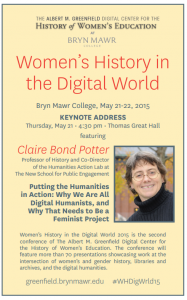 Preparations are in full swing for Women’s History in the Digital World 2015, the second conference of The Albert M. Greenfield Digital Center for the History of Women’s Education, which takes place this Thursday and Friday, May 21-22, at Bryn Mawr College. We are delighted to welcome more than 130 conference participants to campus later this week–including a number of presenters who joined us for the inaugural conference in 2013.
Preparations are in full swing for Women’s History in the Digital World 2015, the second conference of The Albert M. Greenfield Digital Center for the History of Women’s Education, which takes place this Thursday and Friday, May 21-22, at Bryn Mawr College. We are delighted to welcome more than 130 conference participants to campus later this week–including a number of presenters who joined us for the inaugural conference in 2013.
Over two days, conference panels will take us from Medieval Europe to the postwar Middle East to the twenty-first century women’s college campus, and many points in between. To frame our work in feminist studies, we are pleased to be joined by historian Claire Bond Potter, Professor of History and Co-Director of the Humanities Action Lab at The New School. Her Thursday afternoon keynote, “Putting the Humanities in Action: Why We Are All Digital Humanists, and Why That Needs to Be a Feminist Project” builds on our shared interests in bridging fields. Barring technical difficulties, we are especially excited to be able to livestream the keynote address, scheduled for 4:30-5:30pm EST on Thursday. The keynote can be accessed at this link. Continue reading
Black at Bryn Mawr: The Walking Tour
The Greenfield Digital Center has been proud to support the work of Praxis III independent study students Emma Kioko ’15 and Grace Pusey ’15, whose semester-long project Black at Bryn Mawr includes a new walking tour of campus featuring their research. In February, Grace shared the origins of the project with readers, and since that time, they have presented their work-in-progress at Bryn Mawr’s Community Learning Day in March and at the Telling Untold Histories unconference earlier this month.
Emma and Grace will debut their walking tour on campus the week of April 21. For more details, see their blog, Black at Bryn Mawr. The project will also be featured at the final Friday Finds event of the semester, this Friday, April 24 from 4-5pm in Canaday 205 (Special Collections Seminar Room).
In May, Grace will debut the project’s digital component, a map of campus built on Google Open Tour Builder, at Women’s History in the Digital World 2015. Future project-related events will be featured on the Black at Bryn Mawr site.
Women’s History in the Digital World 2015: Register now!
Featured
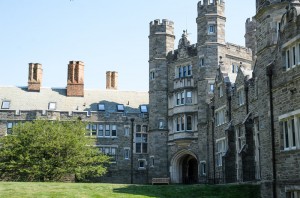
Join us at Bryn Mawr College, May 21-22, 2015! Campus photography via Bryn Mawr College Communications.
Women’s History in the Digital World 2015, the second conference of The Albert M. Greenfield Digital Center for the History of Women’s Education, will be held on the campus of Bryn Mawr College on May 21-22. We aim to bring together experts, novices, and all those in between to share insights, lessons, and resources for the many projects emerging at the crossroads of history, the digital humanities, and women’s and gender studies.
The conference will open Thursday, May 21 with afternoon sessions and a keynote address, followed by a full day of panels scheduled for Friday, May 22. Claire Bond Potter, Professor of History and Co-Director of the Humanities Action Lab at The New School for Public Engagement, will give the conference keynote address at 4:30pm on Thursday, entitled “Putting the Humanities In Action: Why We Are All Digital Humanists, and Why That Needs to Be A Feminist Project.”
A draft program for the two days is now available as a PDF [updated 5/7/15]. We are thrilled to host more than seventy presenters, representing projects from the U.S., Canada, Europe, Asia, and the Middle East.
Bryn Mawr College Community Learning Day: March 18, 2015
Cross-posted from LITS blog:
 Library & Information Technology Services staff and student employees are excited to participate fully in Bryn Mawr’s first Community Learning Day, scheduled for Wednesday, March 18. A number of the day’s interest sessions have been planned by staff and students associated with LITS. They include:
Library & Information Technology Services staff and student employees are excited to participate fully in Bryn Mawr’s first Community Learning Day, scheduled for Wednesday, March 18. A number of the day’s interest sessions have been planned by staff and students associated with LITS. They include:
- Women of Summer, a screening of the documentary film on the Bryn Mawr Summer School for Women Workers in Industry and discussion with filmmaker Rita Heller ’59 and Greenfield Center Assistant Director Evan McGonagill
- Experiences of African American, Latina/o, and Asian American Staff panel, featuring Rod Matthews, Multimedia and Computer Specialist
- Back Talk: Experience, Challenges & Controversy Working with the Bryn Mawr College African Art Collections, highlighting the new Special Collections exhibit in Canaday, including discussion with exhibition organizers Whitney Lopez, ’15 and Brian Wallace, Curator/Academic Liaison for Art & Artifacts
- Black at Bryn Mawr: Walking Tour and Archives Project conversation with Emma Kioko ’15, Grace Pusey ’15, and Greenfield Center Director Monica Mercado, who are working to share stories of Bryn Mawr’s history of race and racism
- Building Institutional Memory workshop, featuring Charlie Bruce ’16 and Rachel Appel, Digital Collections Librarian
These and all of the day’s events are designed to welcome a wide range of participants to learn together. The website will be updated with descriptions for all the interest sessions in the coming week, and you can follow along on Twitter using the hashtag #Mawr2learn. We’ll be tweeting from @BrynMawrLITS and @GreenfieldHWE.
All three libraries will be open, and event programming is scheduled for Carpenter and Canaday. We look forward to learning with you!
For more information and a schedule for the day, including a link to preregistration: https://www.brynmawr.edu/community-learning
#ProjectPerry Preview: Tuesday, January 27 at 4pm

The Relaunching Perry House Committee has been meeting since the fall, and we’re excited to gather on campus this afternoon to share a preview of plans for its reopening, slated for the next academic year.
Details and RSVP here.
Interested in learning more? Earlier this week, committee member Khadijah Seay, Bryn Mawr College Class of 2016, shared some thoughts on her blog, Life at the Mawr.
On the history of Perry House, visit “A Point of Difference: Diversity at Bryn Mawr College,” the digital exhibition created by Alexis de la Rosa, Bryn Mawr College Class of 2015, and Lauren Footman, Bryn Mawr College Class of 2014. Their research provides both the historical context of what was originally designed as a black cultural center at Bryn Mawr College, and highlights some of the original correspondence on the matter between students and administrators in the early 1970s.
As a member of the subcommittees on programming and library space, I’m particularly interested in how we collect the history of Perry House, build on that history, and imagine a vibrant future for the space.

Bryn Mawr College brochure, 1985. See the complete document on Triptych.
One of the things we’ll be discussing in the coming months is the future of the Perry House library, which officially opened in September 1989. As we know from other explorations of campus history, Bryn Mawr College students have often been library builders.

“Realizing the dream” in The College News, September 1989. Read the article here.
The Relaunching Perry House Committee looks forward to collecting community input, as well as reaching out to alumnae/i in the next few months. One way to connect with us is on Twitter: #ProjectPerry. A full list of committee members is online, with plans for a blog coming soon. Thoughts? Memories? Connect with us in the comments below.



